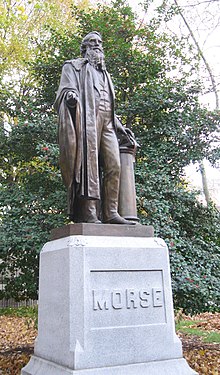So, media ecologists often point to the invention of the telegraph by Samuel F. B. Morse in 1844 as the birth of the electronic, or electric age, the origin of the electronic media environment (which is the media environment, albeit somewhat modified and evolved, that we currently inhabit). Here's what he looked like:
By the way, in addition to being an inventor, Morse was also a renowned painter, a member of the New York University faculty (in arts and design), a proponent of slavery, an anti-Catholic and anti-immigrant activist, and a failed candidate for mayor of New York City. Perhaps, then, it's for the best that he is not remembered as a vivid personality or well rounded historical figure in the manner of Benjamin Franklin, Thomas Edison, or even Alexander Graham Bell.
So, let's just stick with the telegraph, shall we? That's enough to earn you a statue in Central Park, right?
Yes, the telegraph, which Morse actually developed by 1837, 1844 being its public introduction. And actually, there were earlier inventions of the telegraph as well (see the Wikipedia entry on Telegraphy) , but let's not muddy the waters, shall we? If nothing else, Samuel Morse did invent the Morse telegraph, after all.
And the story of why he was motivated to do so is certainly poignant. Here's how Wikipedia tells it:
In 1825, the city of New York commissioned Morse for $1,000 to paint a portrait of Gilbert du Motier, marquis de Lafayette, in Washington. In the midst of painting, a horse messenger delivered a letter from his father that read one line, "Your dear wife is convalescent". Morse immediately left Washington for his home at New Haven, leaving the portrait of Lafayette unfinished. By the time he arrived she had already been buried. Heartbroken in the knowledge that for days he was unaware of his wife's failing health and her lonely death, he moved on from painting to pursue a means of rapid long distance communication.
The thing about the telegraph, though, is that it could transmit sounds (yes it was an acoustic medium, and the first step in reversing the visualism associated with literate and especially typographic culture, and restoring a sense of acoustic space, to use the term favored by Marshall McLuhan, Edmund Carpenter, and others), but could not produce a wide range of sound, certainly not speech. So there needed to be a signal system or symbol system to go with the technology, a bit of software to make the hardware worth using.
And that, of course, was what became known as Morse code. The funny thing is that Morse code wasn't actually invented by Morse, or at least, not fully. Morse just did the numerals, and planned on having a code book with words coded by number. It was his assistant, Alfred Vail, who came up with all of the codes for the letters of the alphabet, which is what makes the Morse code truly useful. So I guess it should have been called Vail code, or at least Morse-Vail code, but that's the way things go here in the United States of Columbia, or is it the United States of Leifland?
Anyway, the Wikipedia entry on Morse code describes it as
a type of character encoding that transmits telegraphic information using rhythm. Morse code uses a standardized sequence of short and long elements to represent the letters, numerals, punctuation and special characters of a given message. The short and long elements can be formed by sounds, marks, or pulses, in on off keying and are commonly known as "dots" and "dashes" or "dits" and "dahs".
On that last bit, when spoken or sometimes when written, the dot is represented by "dit" when it's by itself or appears at the end of a word, or by a "di" when it appears at the beginning of a word, or somewhere in the middle. And the dash is represented by a "dah" for all cases. And here's a chart, to help visualize it all:
International Morse code is a modified form of the code that was developed by Morse and Vail, but the basic principles remain the same.
So, once upon a time, telegraph and wireless telegraph operators were part of the first internet, Tom Standage referred to it as the Victorian internet, and it was basic knowledge for anyone dealing with ships and airplanes, and for amateur radio operators. And everyone knew that S.O.S. was signaled by three dots, followed by three dashes, followed by three dots.
And no, I never learned Morse code myself, but I was a bit taken aback a few years ago when I heard that the FCC was no longer requiring knowledge of Morse code for amateur radio licenses. It signaled the end of an era.
Does it matter? Perhaps not, not with the internet itself providing such ease of communication, along with mobile phones and satellite phones. It's quite possible that Morse code's time has come and gone. But somehow it does seem to be part and parcel of the passing of an era, a lost skill not unlike reading the clockface, or a newspaper, or tying your shoes, albeit a skill that was much more specialized and limited to a minority of operators.
Anyway, it gave me an idea for a poem, albeit one that was a bit gimmicky, but it actually took me a couple of years to get past the first two lines, and figure out a way to pull it off. I finally got it all together this past spring, and posted it over on my MySpace poetry blog earlier this month. So, I thought I'd share it with you here on Blog Time Passing as well.
No Remorse
There was an age
when the wires sang
with buzzes and beeps
both short and long!
dah-di-dit dah-dah-dah dah di-di-dit
-•• --- - •••
Back and forth the electric
alphabet rang
like church bells playing
a mighty song!
dah-di-dit di-dah di-di-dit di-di-di-dit dit di-di-dit
-•• •- ••• •••• • •••
There was an age
when the airwaves hummed
the spectrum filled
with unearthly tones!
dah-dah dah-dah-dah di-dah-dit di-di-dit dit
-- --- •-• ••• •
Through the skies above
the rhythms thummed
with ethereal
ghostly moans!
dah-di-dah-dit dah-dah-dah dah-di-dit dit
-•-• --- -•• •
Operators played
their magnetic keys
keeping the beat
with style and flair!
dah dit di-dah-di-dit dit
- • •-•• •
dah-dah-dit di-dah-dit di-dah di-dah-dah-dit di-di-di-dit
--• •-• •- •--• ••••
Across the continent
and overseas
sending their messages
with skill and care!
di-dah-dah di-dit di-dah-dit dit
•-- •• •-• •
di-dah-di-dit dit di-di-dit di-di-dit
•-•• • ••• •••
From Maine to Texas
and beyond
great distances bridged
at a speed sublime!
dit di-dit dah-dah-dit di-di-di-dit
• •• --• ••••
dah dit dit dah-dit
- • • -•
Uniting us all
in a common bond
one neighborhood
out of space and time!
di-di-dah-dit dah-dah-dah di-dah-dit dah dah-di-dah-dah
••-• --- •-• - -•--
di-di-dah-dit dah-dah-dah di-di-dah di-dah-dit
••-• --- ••- •-•
And now new songs
fill the atmosphere
and travel along wires
that encircle the Earth!
di-di-dit di-dah dah-dah di-di-dah dit di-dah-di-dit
••• •- -- ••- • •-••
But listening hard
you still can hear
the binary tune
from that moment of birth!
dah-dah dah-dah-dah di-dah-dit di-di-dit dit
-- --- •-• ••• •
And here is a video illustrating the Morse code alphabet, for your listening pleasure:
And this Morse code music video is very cool indeed:
But perhaps the most dramatic use of Morse code, and one I remember seeing on television when I was a kid, was the case of Jeremiah Denton--here's an excerpt from his Wikipedia entry:
While serving as Naval Aviator during the Vietnam War, Denton was Commanding Officer (CO) of Attack Squadron SEVENTY-FIVE (VA-75) aboard the aircraft carrier USS Independence (CVA 62). On 18 July 1965, then-Commander Denton was flying an A-6A Intruder, Bureau Number 151577, from the Independence with his bombardier/navigator, Lieutenant, junior grade Bill Tschudy, to participate in a bombing mission over the Vietnamese city of Thanh Hoa. Their plane was shot down and the two men were captured by hostile forces. Denton and Tschudy were both held as prisoners of war for almost eight years, four of which were spent in solitary confinement. Denton is best known for the 1966 North Vietnamesemorse code to spell out the word "T-O-R-T-U-R-E" to communicate that his captors were torturing him and his fellow POWs. television interview he was forced to give as a prisoner, in which he ingeniously used the opportunity to communicate to American Intelligence. During the interview Denton blinked his eyes in
And courtesy of YouTube, here's the actual clip:
From the young David Sarnoff relaying messages about the sinking of the Titannic via wireless, to Jeremiah Denton's courageous defiance of his captors, there is something romantic and heroic about Morse code that's worthy of note, as we witness its passing into the long night of obsolescence.
And di-di-di-di-di-di-dat's all, folks!














7 comments:
Fascinating. The poem is brilliant and challenging and my favorite bit is:
"...but that's the way things go here in the United States of Columbia, or is it the United States of Leifland?"
I went to high school about a 15-20 minute walk from the Samuel Morse House in Poughkeepsie but never had occasion to go in. I'll have to make that trip someday.
Thanks!
Thank you, Mike, and I never knew about the Morse house, sounds like it's worth a look!
If the stars are aligned right, maybe we could make the trip up to Poughkeepsie together for that visit. Those are my old stomping grounds and could be a nice place to visit when the leaves are changing.
sounds good!
I'm reading Tom Standage's The Victorian Internet right now and it's amazing. It supports many of media ecology's tenets about the telegraph as a medium. It's a quick and enlightening read.
Thomas Edison was no saint either. His close friendship with Henry Ford supports the assertions that have been made that he was a rabid anti-semite.
no doubt about it, Edison was a bastard, and Ford even worse. Perhaps the negative qualities of so many inventors tells us something about the nature of technological innovation, and what Ellul called la technique, and Postman technopoly?
Post a Comment